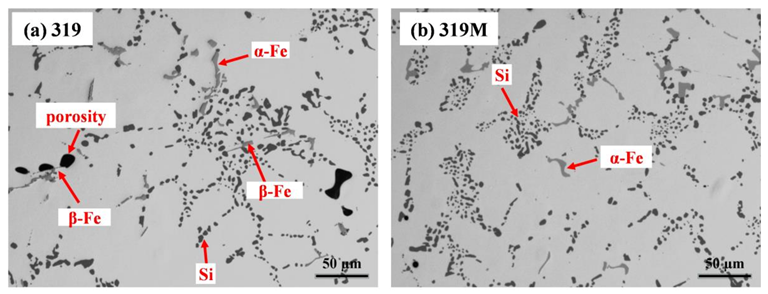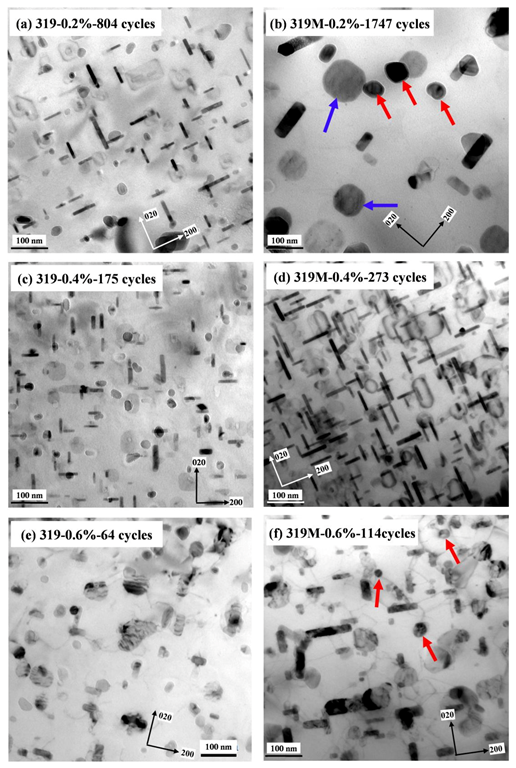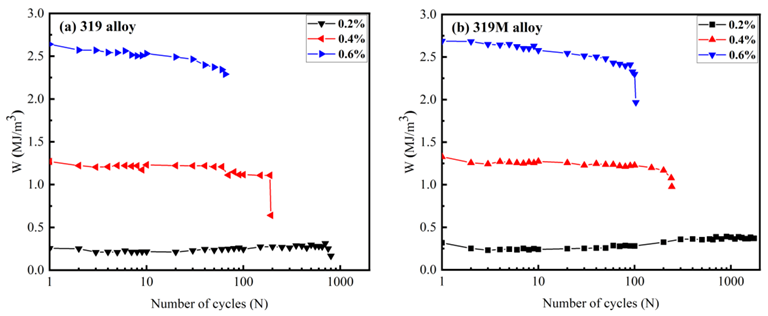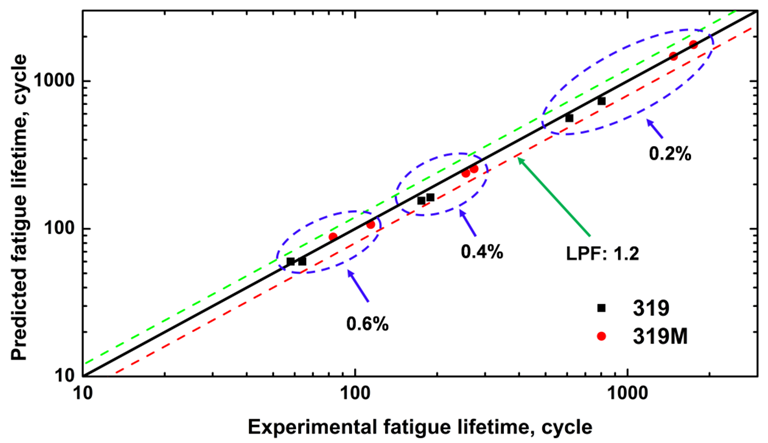Improved Thermo-Mechanical Fatigue Resistance of Al-Si-Cu 319 Alloys by Microalloying with Mo
Abstract
:1. Introduction
2. Materials and Methods
3. Results
3.1. T7-Treated Microstructures
3.2. TMF Behaviors
4. Discussion
4.1. Microstructure Evolution during TMF and the Role of Mo in Enhancing TMF Resistance
4.2. Prediction of TMF Lifetime
5. Conclusions
- (1)
- Cyclic stress softening occurred in both experimental alloys during the TMF tests; however, the softening rate of the Mo-modified 319M alloy was lower than that of the base 319 alloy.
- (2)
- The TMF lifetime decreased with an increasing strain amplitude. The alloy 319M exhibited a longer TMF lifetime than 319 under the same strain amplitude.
- (3)
- The θ’-Al2Cu precipitates in both experimental alloys underwent coarsening during TMF cycling. However, the coarsening rate per cycle of θ’-Al2Cu in the 319M alloy was significantly lower than that in the 319 base alloy.
- (4)
- Microalloying the Al-Si-Cu 319 alloy with Mo promoted the formation of a large number of thermally stable Mo-containing α-dispersoids and therefore improved the TMF resistance mainly by slowing the coarsening of θ’-Al2Cu precipitates and providing supplementary strengthening to the Al matrix.
Author Contributions
Funding
Institutional Review Board Statement
Informed Consent Statement
Data Availability Statement
Acknowledgments
Conflicts of Interest
References
- Javidani, M.; Larouche, D. Application of cast Al–Si alloys in internal combustion engine components. Int. Mater. Rev. 2014, 59, 132–158. [Google Scholar] [CrossRef]
- Grieb, M.B.; Christ, H.-J.; Plege, B. Thermomechanical fatigue of cast aluminium alloys for cylinder head applications–Experimental characterization and life prediction. Procedia Eng. 2010, 2, 1767–1776. [Google Scholar] [CrossRef]
- Hu, X.; Shi, D.; Yang, X. Thermomechanical fatigue experimental study on a notched directionally solidified Ni-base superalloy. Mater. Sci. Eng. A 2016, 674, 451–458. [Google Scholar] [CrossRef]
- Moverare, J.J.; Johansson, S.; Reed, R.C. Deformation and damage mechanisms during thermal–mechanical fatigue of a single-crystal superalloy. Acta Mater. 2009, 57, 2266–2276. [Google Scholar] [CrossRef]
- Segersäll, M.; Kontis, P.; Pedrazzini, S.; Bagot, P.A.J.; Moody, M.P.; Moverare, J.J.; Reed, R.C. Thermal–mechanical fatigue behaviour of a new single crystal superalloy: Effects of Si and Re alloying. Acta Mater. 2015, 95, 456–467. [Google Scholar] [CrossRef]
- Hähner, P.; Rinaldi, C.; Bicego, V.; Affeldt, E.; Brendel, T.; Andersson, H.; Beck, T.; Klingelhöffer, H.; Kühn, H.-J.; Köster, A.; et al. Research and development into a European code-of-practice for strain-controlled thermo-mechanical fatigue testing. Int. J. Fatigue 2008, 30, 372–381. [Google Scholar] [CrossRef]
- Cole, G.S.; Sherman, A.M. Light weight materials for automotive applications. Mater. Charact. 1995, 35, 3–9. [Google Scholar] [CrossRef]
- Liu, K.; Wang, S.; Pan, L.; Chen, X.-G. Thermo-Mechanical Fatigue Behavior and Resultant Microstructure Evolution in Al–Si 319 and 356 Cast Alloys. Materials 2023, 16, 829. [Google Scholar] [CrossRef]
- Moverare, J.J. Thermal–mechanical fatigue behaviour of CMSX-4 in virgin and long term aged conditions. Mater. Sci. Technol. 2007, 23, 1450–1453. [Google Scholar] [CrossRef]
- Ye, H. An overview of the development of Al–Si–Alloy based material for engine applications. J. Mater. Eng. Perform. 2003, 12, 288–297. [Google Scholar] [CrossRef]
- Huter, P.; Oberfrank, S.; Grün, F.; Stauder, B. Thermo-mechanical fatigue influence of copper and silicon on hypo-eutectic Al–Si–Cu and Al–Si–Mg cast alloys used in cylinder heads. Int. J. Fatigue 2016, 88, 142–155. [Google Scholar] [CrossRef]
- Moizumi, K.; Mine, K.; Tezuka, H.; Sato, T. Influence of Precipitate Microstructures on Thermal Fatigue Properties of Al-Si-Mg Cast Alloys. Mater. Sci. Forum 2002, 396–402, 1371–1376. [Google Scholar] [CrossRef]
- Sehitoglu, H.; Engler-Pinto, C.; Maier, H.; Foglesong, T. Thermomechanical deformation of AL319 Alloys with different iron contents. In Proceedings of the CAMP 2000—The High-temperature Fatigue, Bad Lippspringe, Germany, 3–4 April 2002; pp. 76–83. [Google Scholar]
- Wang, M.; Pang, J.; Liu, X.; Wang, J.; Liu, Y.; Li, S.; Zhang, Z. Optimization of Thermo-Mechanical Fatigue Life for Eutectic Al-Si Alloy by the Ultrasonic Melt Treatment. Materials 2022, 15, 7113. [Google Scholar] [CrossRef]
- Firouzdor, V.; Rajabi, M.; Nejati, E.; Khomamizadeh, F. Effect of microstructural constituents on the thermal fatigue life of A319 aluminum alloy. Mater. Sci. Eng. A 2007, 454–455, 528–535. [Google Scholar] [CrossRef]
- Chen, S.; Liu, K.; Chen, X.G. Precipitation behavior of dispersoids and elevated-temperature properties in Al–Si–Mg foundry alloy with Mo addition. J. Mater. Res. 2019, 34, 3071–3081. [Google Scholar] [CrossRef]
- Farkoosh, A.R.; Grant Chen, X.; Pekguleryuz, M. Dispersoid strengthening of a high temperature Al–Si–Cu–Mg alloy via Mo addition. Mater. Sci. Eng. A 2015, 620, 181–189. [Google Scholar] [CrossRef]
- Jin, L.; Liu, K.; Chen, X.-G. Improved Elevated Temperature Properties in Al–13%Si Piston Alloys by Mo Addition. J. Mater. Eng. Perform. 2020, 29, 126–134. [Google Scholar] [CrossRef]
- Jin, L.; Liu, K.; Chen, X.G. Evolution of Fe-Rich Intermetallics in Al–Si–Cu 319 Cast Alloy with Various Fe, Mo, and Mn Contents. Metall. Mater. Trans. B 2019, 50, 1896–1907. [Google Scholar] [CrossRef]
- Jin, L.; Liu, K.; Chen, X.G. Evolution of dispersoids and their effects on elevated-temperature strength and creep resistance in Al–Si–Cu 319 cast alloys with Mn and Mo additions. Mater. Sci. Eng. A 2020, 770, 138554. [Google Scholar] [CrossRef]
- Qin, J.; Racine, D.; Liu, K.; Chen, X.-G. Strain-controlled thermo-mechanical fatigue testing of aluminum alloys using the Gleeble 3800 system. In Proceedings of the 16th International Aluminum Alloys Conference (ICAA 16), Montreal, QC, Canada, 17–21 June 2018; Brochu, M., Wells, M., Eds.; Canadian Institute of Mining, Metallurgy & Petroleum: Montreal, QC, Canada. ISBN 978-1-926872-41-4. [Google Scholar]
- Cao, X.; Campbell, J. The nucleation of Fe-Rich phases on oxide films in Al–11.5Si–0.4Mg cast alloys. Metall. Mater. Trans. A 2003, 34, 1409–1420. [Google Scholar] [CrossRef]
- Samuel, A.; Zedan, Y.; Doty, H.; Songmene, V.; Samuel, F.H. A Review Study on the Main Sources of Porosity in Al-Si Cast Alloys. Adv. Mater. Sci. Eng. 2021, 2021, 1921603. [Google Scholar] [CrossRef]
- Liu, K.; Ma, H.; Chen, X.G. Enhanced elevated-temperature properties via Mo addition in Al–Mn–Mg 3004 alloy. J. Alloys Compd. 2017, 694, 354–365. [Google Scholar] [CrossRef]
- Rakhmonov, J.; Liu, K.; Rometsch, P.; Parson, N.; Chen, X.G. Effects of Al(MnFe)Si dispersoids with different sizes and number densities on microstructure and ambient/elevated-temperature mechanical properties of extruded Al–Mg–Si AA6082 alloys with varying Mn content. J. Alloys Compd. 2021, 861, 157937. [Google Scholar] [CrossRef]
- Kaufman, J.G. Properties of Aluminum Alloys: Tensile, Creep, and Fatigue Data at High and Low Temperatures; ASM International: Materials Park, OH, USA; Aluminum Association: Washington, DC, USA, 1999. [Google Scholar]
- Khisheh, S.; Azadi, M.; Hendoabadi, V.Z.; Parast, M.S.A.; Winter, G.; Seisenbacher, B.; Gruen, F.; Khalili, K. Influence of T6 heat-treating and over-ageing on out-of-phase thermo-mechanical fatigue behaviors of Al-Si-Cu alloy. Mater. Today Commun. 2022, 33, 104803. [Google Scholar] [CrossRef]
- Li, Z.; Li, J.; Chen, Z.; Guo, J.; Zhu, Y.; Luo, Y. Experimental and computational study on thermo-mechanical fatigue life of aluminium alloy piston. Fatigue Fract. Eng. Mater. Struct. 2021, 44, 141–155. [Google Scholar] [CrossRef]
- Baldan, A. Review Progress in Ostwald ripening theories and their applications to nickel-base superalloys Part I: Ostwald ripening theories. J. Mater. Res. 2002, 37, 2171–2202. [Google Scholar]
- Lifshitz, I.M.; Slyozov, V.V. The kinetics of precipitation from supersaturated solid solutions. J. Phys. Chem. Solids 1961, 19, 35–50. [Google Scholar] [CrossRef]
- Lai, J.; Zhang, Z.; Chen, X.G. The thermal stability of mechanical properties of Al–B4C composites alloyed with Sc and Zr at elevated temperatures. Mater. Sci. Eng. A 2012, 532, 462–470. [Google Scholar] [CrossRef]
- Chen, Y.H.; Doherty, R.D. On the growth kinetics of plate-shaped precipitates in aluminium-copper and aluminium-gold alloys. Scripta Metall. 1977, 11, 725–729. [Google Scholar] [CrossRef]
- Liu, G.; Zhang, G.J.; Ding, X.D.; Sun, J.; Chen, K.H. Modeling the strengthening response to aging process of heat-treatable aluminum alloys containing plate/disc- or rod/needle-shaped precipitates. Mater. Sci. Eng. A 2003, 344, 113–124. [Google Scholar] [CrossRef]
- De Luca, A.; Shu, S.; Seidman, D.N. Effect of microadditions of Mn and Mo on dual L12- and α-precipitation in a dilute Al-Zr-Sc-Er-Si alloy. Mater. Charact. 2020, 169, 110585. [Google Scholar] [CrossRef]
- Ding, J.; Cui, C.; Sun, Y.; Zhao, L.; Cui, S. Effect of Mo, Zr, and Y on the high-temperature properties of Al–Cu–Mn alloy. J. Mater. Res. 2019, 34, 3853–3861. [Google Scholar] [CrossRef]
- Sitdikov, O.; Avtokratova, E.; Sakai, T.; Tsuzaki, K. Ultrafine-Grain Structure Formation in an Al–Mg–Sc Alloy during Warm ECAP. Metall. Mater. Trans. A 2013, 44, 1087–1100. [Google Scholar] [CrossRef]
- Ceschini, L.; Boromei, I.; Morri, A.; Seifeddine, S.; Svensson, I.L. Effect of Fe content and microstructural features on the tensile and fatigue properties of the Al–Si10–Cu2 alloy. Mater. Des. 2012, 36, 522–528. [Google Scholar] [CrossRef]
- Liu, K.; Cao, X.; Chen, X.G. Tensile properties of Al-Cu 206 cast alloys with various iron contents. Metall. Mater. Trans. A 2014, 45, 2498–2507. [Google Scholar] [CrossRef]
- Eichlseder, W.; Winter, G.; Farrahi, G.H.; Azadi, M. The Effect of Various Parameters on Out-of-Phase Thermo-Mechanical Fatigue Lifetime of A356.0 Cast Aluminum Alloy. Int. J. Eng. 2013, 26, 1461–1470. [Google Scholar]
- Miller, M.P.; McDowell, D.L.; Oehmke, R.L.T. A Creep-Fatigue-Oxidation Microcrack Propagation Model for Thermomechanical Fatigue. J. Eng. Mater. Technol. 1992, 114, 282–288. [Google Scholar] [CrossRef]
- Neu, R.W.; Sehitoglu, H. Thermomechanical fatigue, oxidation, and Creep: Part II. Life prediction. Metall. Trans. A 1989, 20, 1769–1783. [Google Scholar] [CrossRef]
- Azadi, M. Effects of strain rate and mean strain on cyclic behavior of aluminum alloys under isothermal and thermo-mechanical fatigue loadings. Int. J. Fatigue 2013, 47, 148–153. [Google Scholar] [CrossRef]
- Wang, M.; Pang, J.C.; Zhang, M.X.; Liu, H.Q.; Li, S.X.; Zhang, Z.F. Thermo-mechanical fatigue behavior and life prediction of the Al-Si piston alloy. Mater. Sci. Eng. A 2018, 715, 62–72. [Google Scholar] [CrossRef]
- Riedler, M.; Leitner, H.; Prillhofer, B.; Winter, G.; Eichlseder, W. Lifetime simulation of thermo-mechanically loaded components. Meccanica 2007, 42, 47–59. [Google Scholar] [CrossRef]
- Gocmez, T.; Awarke, A.; Pischinger, S. A new low cycle fatigue criterion for isothermal and out-of-phase thermomechanical loading. Int. J. Fatigue 2010, 32, 769–779. [Google Scholar] [CrossRef]
- Farrahi, G.H.; Azadi, M.; Winter, G.; Eichlseder, W. A new energy-based isothermal and thermo-mechanical fatigue lifetime prediction model for aluminium–silicon–magnesium alloy. Fatigue Fract. Eng. Mater. Struct. 2013, 36, 1323–1335. [Google Scholar] [CrossRef]










| Alloy | Si | Cu | Mg | Mn | Fe | Ti | Sr | Mo | Al |
|---|---|---|---|---|---|---|---|---|---|
| 319 | 5.93 | 3.34 | 0.12 | 0.28 | 0.31 | 0.11 | 0.011 | - | Bal. |
| 319M | 6.00 | 3.50 | 0.11 | 0.30 | 0.30 | 0.10 | 0.010 | 0.3 | Bal. |
| θ’-Al2Cu | Length, nm | Width, nm | Number Density, μm−1 |
|---|---|---|---|
| 319 | 48 | 4.2 | 4251 |
| 319M | 65 | 5.4 | 3953 |
| Dispersoids | Equivalent diameter, nm | Area fraction, % | |
| 319 | 55 | 0.4 | |
| 319M | 43 | 3.1 | |
| Strain Amplitude, % | 0.1 | 0.2 | 0.4 | 0.6 | ||||
|---|---|---|---|---|---|---|---|---|
| Alloy | 319 | 319M | 319 | 319M | 319 | 319M | 319 | 319M |
| Pre-test cycles | 27 | 28 | 29 | 28 | 26 | 31 | 28 | 39 |
| Maximum tensile stress at 2nd cycle, MPa | 87.6 | 96.6 | 159.3 | 176.5 | 215.2 | 213.4 | 243.6 | 223.5 |
| Alloys | Conditions (Strain Amplitude and Cycle Number) | Length | Width | Number Density |
|---|---|---|---|---|
| (nm) | (nm) | (μm−1) | ||
| 319 | 0.2%, 804 cycles | 115.9 | 12.1 | 501 |
| 0.4%, 175 cycles | 83.9 | 10.5 | 789 | |
| 0.6%, 64 cycles | 80.1 | 18.1 | 691 | |
| 319M | 0.2%, 1747 cycles | 131.2 | 36 | 131 |
| 0.4%, 273 cycles | 90.2 | 10.9 | 852 | |
| 0.6%, 114 cycles | 78.1 | 19.2 | 521 |
| Alloy | Strain Amplitude, % | ||
|---|---|---|---|
| 0.2 | 0.4 | 0.6 | |
| 319 | 3.5 | 6.2 | 16 |
| 319M | 1.8 | 3.6 | 4.2 |
| Alloy | W0 (MJ/m3) | β |
|---|---|---|
| 319 | 107.75 | 1.09 |
| 319M | 200.91 | 1.07 |
Disclaimer/Publisher’s Note: The statements, opinions and data contained in all publications are solely those of the individual author(s) and contributor(s) and not of MDPI and/or the editor(s). MDPI and/or the editor(s) disclaim responsibility for any injury to people or property resulting from any ideas, methods, instructions or products referred to in the content. |
© 2023 by the authors. Licensee MDPI, Basel, Switzerland. This article is an open access article distributed under the terms and conditions of the Creative Commons Attribution (CC BY) license (https://creativecommons.org/licenses/by/4.0/).
Share and Cite
Liu, K.; Wang, S.; Hu, P.; Pan, L.; Chen, X.-G. Improved Thermo-Mechanical Fatigue Resistance of Al-Si-Cu 319 Alloys by Microalloying with Mo. Materials 2023, 16, 3515. https://doi.org/10.3390/ma16093515
Liu K, Wang S, Hu P, Pan L, Chen X-G. Improved Thermo-Mechanical Fatigue Resistance of Al-Si-Cu 319 Alloys by Microalloying with Mo. Materials. 2023; 16(9):3515. https://doi.org/10.3390/ma16093515
Chicago/Turabian StyleLiu, Kun, Shuai Wang, Peng Hu, Lei Pan, and X.-Grant Chen. 2023. "Improved Thermo-Mechanical Fatigue Resistance of Al-Si-Cu 319 Alloys by Microalloying with Mo" Materials 16, no. 9: 3515. https://doi.org/10.3390/ma16093515
APA StyleLiu, K., Wang, S., Hu, P., Pan, L., & Chen, X.-G. (2023). Improved Thermo-Mechanical Fatigue Resistance of Al-Si-Cu 319 Alloys by Microalloying with Mo. Materials, 16(9), 3515. https://doi.org/10.3390/ma16093515







